Kibble is really hard, and as most hard little nuggets contain as little as 10% moisture you have to question how good this is for your dog?
Fresh meat, which our dogs would happily devour in the wild, contains upwards of 70% moisture. This difference has led some people to wonder if adding water to kibble might be beneficial.
In this article, we’ll explore the pros and cons of adding water to dry dog food, how to do it, and common concerns. We also ran an experiment soaking ACANA dog food in both room temperature and warm water!
The Pros and Cons of Adding Water to Dry Dog Kibble
Adding water to dry dog kibble has its benefits and drawbacks. Here are some of the pros and cons of this practice:
Benefits of Adding Water to Kibble
- Improved hydration – By adding water to kibble, you can increase your dog’s water intake, which is especially important for dogs who don’t drink enough water on their own. This can help prevent dehydration and prevent health problems.
- Easier digestion – Soaking kibble can make it easier to digest by breaking down the hard pieces of food. You may not know this, but a dog’s digestive tract is shorter than ours, which means they may not fully digest kibble before it comes out the other end.
- Fresh, clean water – We know the benefits of fresh, clean water for our health, and it’s the same for our dogs. Most kibble-fed dogs can suffer from poor digestion and organ health from an absence of moisture in their diet. Sometimes it takes years for symptoms to show, so adding clean water to their kibble can work wonders.
- Dental health – If your dog is suffering from poor dental health or dental pain, then softening kibble with moisture can help them consume their daily intake of nutrition. Just note, if they’re suffering dental pain you must keep your vet involved, and dental extraction could be your best way forward (an operation under anesthetic). If your dog is not suffering dental issues, then chewing on a raw meaty bone will likely be far more effective solution to keep their teeth in good health.
Drawbacks of Adding Water to Kibble
- Potential for bacterial growth – If left sitting for too long, moist kibble can become a breeding ground for bacteria, especially in warm or humid Aussie environments. This can lead to foodborne illness and other health problems for your dog. Because of this, don’t leave wet kibble in the bowl too long (or dry kibble for that matter).
- Change in taste and texture – Adding water to kibble can change its texture and taste, which some dogs may not like. This can make it harder to get them to eat their food and can lead to nutritional deficiencies.
- Time-consuming – Adding water to kibble takes time and effort, especially if you have multiple dogs or need to prepare multiple meals a day. This can be inconvenient for busy dog owners or those with hectic schedules. I get busy myself, so I get it!
Overall, the decision to add water to dry dog kibble depends on your individual dog’s needs and preferences. It’s important to weigh the pros and cons before making a decision and to follow best practices for soaking kibble to ensure your dog’s safety and health.
If you think your dog doesn’t drink enough, or doesn’t have enough clean water in their diet, then soaking kibble can be a great idea!
Best Practices for Soaking Kibble
Okay, so you’ve decided you want to soak your dog’s kibble, but is it as easy as adding water? Well, mostly, but here are some tips:
How to Soften Dog Kibble
- Warm water soak – The easiest way to soften kibble is to soak it in warm water for 10-15 minutes. This will help break down the kibble and make it easier to digest. Just make sure the water isn’t too hot, as this can destroy some of the nutrients in the food. Do not use water straight from the kettle!
- Room temperature soak – If you prefer not to use warm water, you can also soak kibble in room temperature water for a longer period of time, such as 30 minutes to an hour. This method may take longer, but it’s still effective in softening the kibble.
How Long to Soak Kibble
- Recommended soaking time – The recommended soaking time for kibble is 10-15 minutes, although this can vary depending on the type of kibble and your dog’s individual needs. You can also adjust the amount of water you use depending on your dog’s preference for a softer or firmer texture. It also depends on the brand of kibble, and you’ll find some break down quickly whereas others barely break down at all – you have to question whether those kibbles are beneficial for your dog!
- Adjusting for individual dogs – Some dogs may need longer soaking times or more water to achieve the desired texture. If your dog has dental issues or is prone to bloating, you may want to soak the kibble for longer to make it easier for them to eat. Be sure to monitor your dog’s reactions to soaked kibble and adjust the soaking time and amount of water as needed.
By following these best practices, you’ll quickly figure out what your furry friend prefers!
The Experiment! Soaking ACANA Dog Food
PRODUCT: ACANA Classics Red Meat for Dogs
I feed my dog ACANA which is the reason this product was used for the experiment. I’ve done this before with cheaper kibble and found it not to moisten so readily. This is a good sign ACANA will likely be more digestible to your dog.
On the left: Room temperature water.
On the right: Warm water.
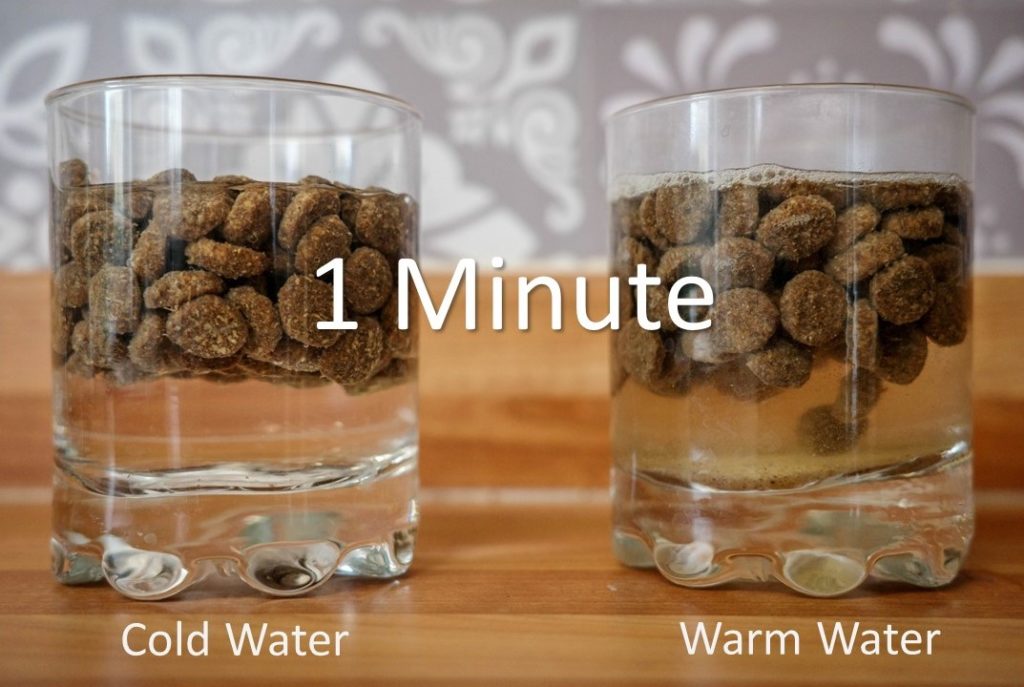
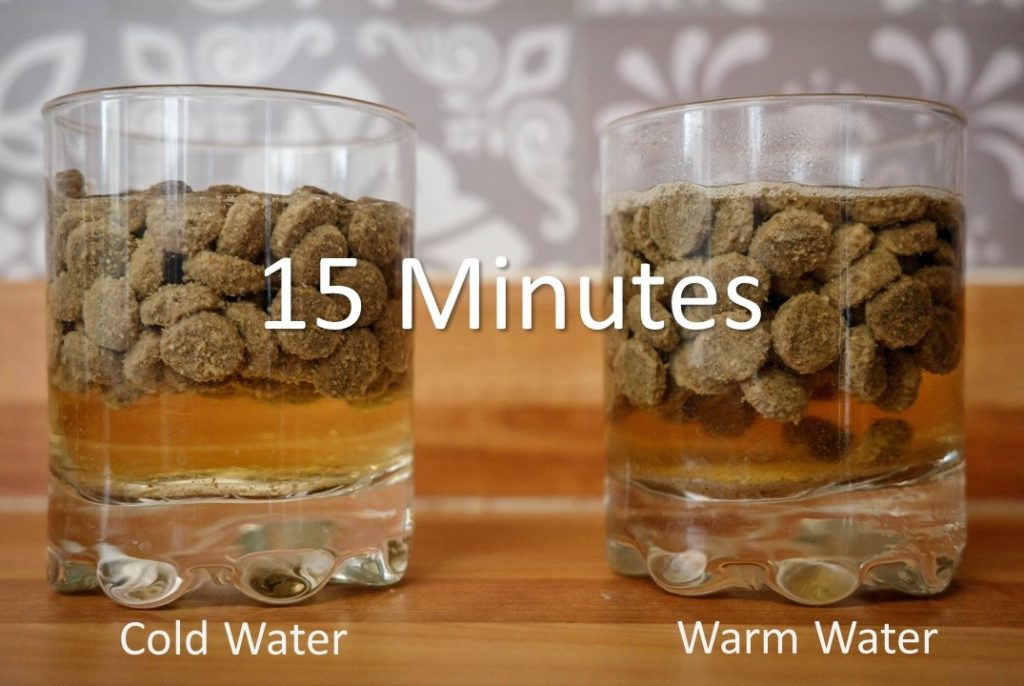
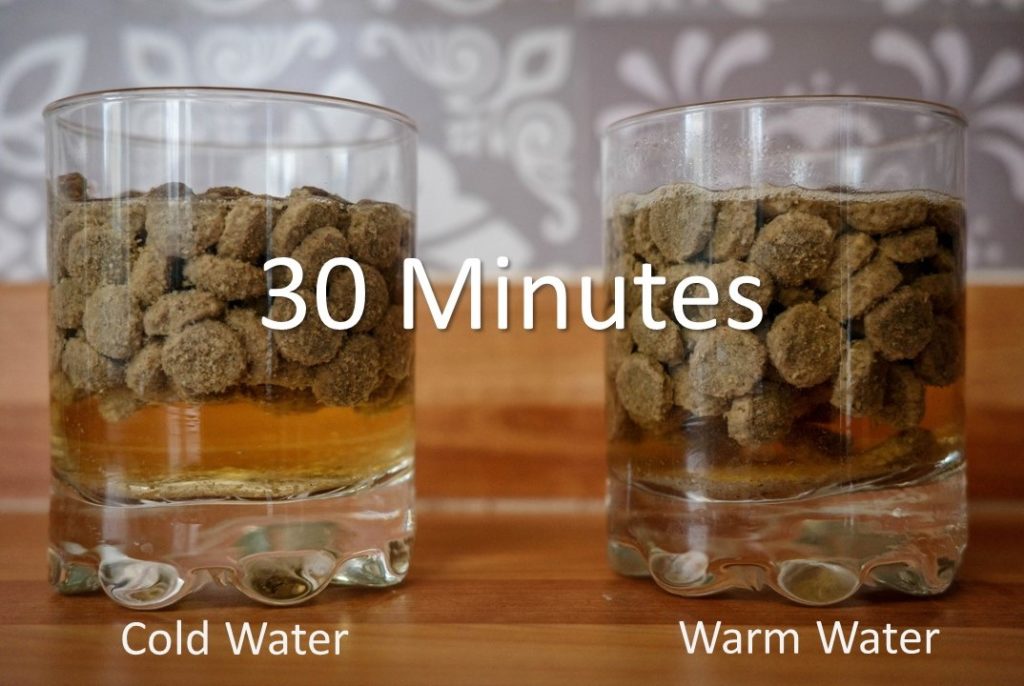
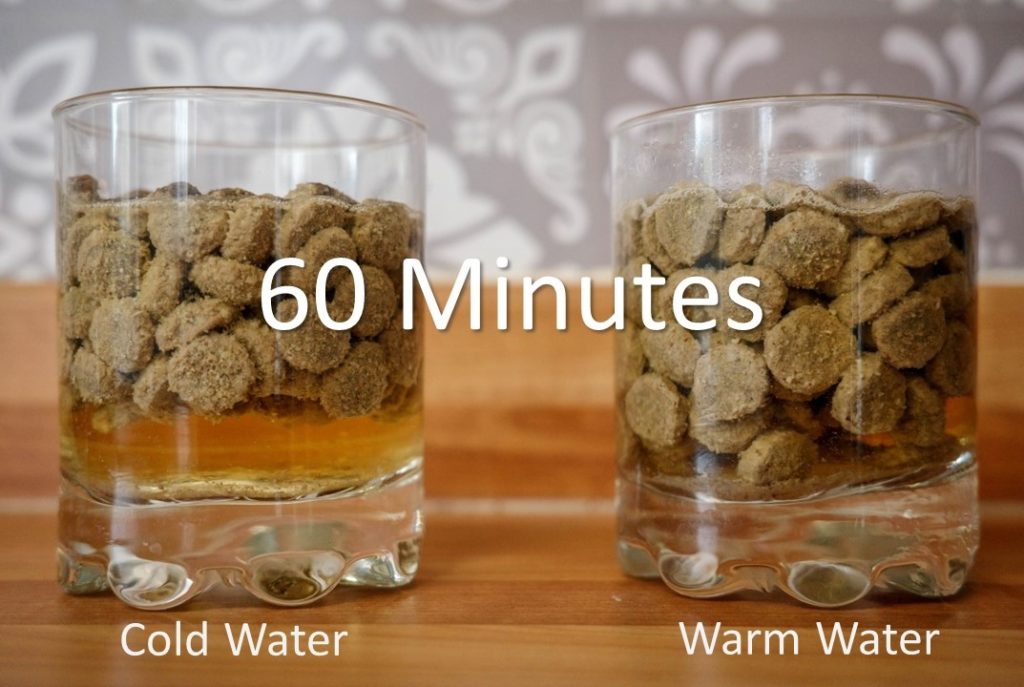
The conclusion from the experiment was warm water began to soften the kibble almost immediately (see 1 minute).
From the 30 minute and 60 minute pictures it is clear warm water is far more effective at moistening dog food. In fact, it took twice as long for the cold water to moisten the kibble (compare the 30 minute and 60 minute pictures).
Alternatives to Soaking Kibble
When soaking kibble we’re addressing the lack of moisture in dry food. It’s worth noting some brands of dog food in Australia already address this concern, from freeze-dried foods (like Frontier Pets) which you add water to, or air-dried (like ZiwiPeak and Eureka), to all manner of BARF and raw food diets which are full of moisture.
Another alternative to soaking kibble is to add wet dog food, rolls, BARF, or fresh meats to your dogs diet. These foods have much more moisture than dry dog food.
Can Kibble be Hard to Digest?
The length of a digestive system plays a big part in what an animal can digest. This also gives evidence on whether an animal is a carnivore or omnivore.
When it comes to kibble, the ability for a dog to digest it depends on two factors – how hard it is (some kibble is harder than others), and what ingredients it is made from.
Assessing the Facts of the Digestive Systems of Dogs, Cats, and Us
Let’s take into consideration the following comparisons between the digestive systems of a cat, dog, and human:
- Dogs
- Dogs are classified mostly as carnivores. Although this is disputed, their digestive system is adapted for processing animal protein and fat.
- Their digestive tract is relatively short, with food typically taking around 8-10 hours to pass through from the mouth to the anus.
- Cats
- Cats are classified as carnivores (undisputed), with a digestive system which is similar to dogs in many ways.
- Like dogs, their digestive tract is relatively short, with food typically taking around 8-12 hours to pass through from the mouth to the anus.
- Humans
- Humans are classified as omnivores, with a digestive system that is adapted for processing both animal and plant-based foods.
- Our digestive tract is longer than that of dogs and cats, with food taking from 24 to 72 hours to pass through from the mouth to the anus, depending on the individual’s diet and other factors.
What we can conclude from the above is a dog has a digestive system more similar to a cat than to ours, which will have an impact on how quickly they can digest food.
How Proteins, Fats, and Carbohydrates in Kibble Affect Digestion
Meat is generally quicker to digest compared to grains because meat is primarily made up of protein and fat, which are relatively simple to break down and absorb in the digestive system. This is the case for humans and animals alike.
In contrast, grains are primarily composed of carbohydrates, which are more complex molecules. These require more time and energy to digest.
Dry dog food is mostly grain-based, or if not grain then carbohydrate-based. A kibble will also include protein and fat, but it’s the carbohydrates (or starches) which allow it to be made into what we recognise as kibble (or biscuits).
For a dog or cat, the concern is they may not fully digest a kibble during their period of digestion prior to excreting nutrients. As a kibble is a mixture of carbohydrates, proteins, and fats, they may not be able to digest the key nutrients efficiently.
Soaking kibble therefore gives a head start in the digestive process by breaking down the nutrients, hopefully increasing the rate of absorption, and letting the high acidity of their stomachs do the rest.
An Opinion from an Australian Vet
In the following video Australian vet Dr. Tom Lonsdale, author of Raw Meaty Bones, discusses a client’s dog who has failed to digest Nestle Purina Supercoat, a popular brand of dog food Australia:
Misconceptions About Soaking Kibble
As with anything on the Internet these days, there are of course misconceptions about soaking kibble. Let’s address them:
Does Soaking Kibble Help Prevent Bloat?
Some dog owners believe soaking kibble can help prevent bloat, a serious condition where the stomach twists and fills with gas. Although it’s possible, there is no definitive evidence to support this claim. Assessing the brand of kibble and it’s appropriateness for a canine is a better thing to consider, as well as taking your vet’s advice.
While adding water to kibble can help with hydration and digestion, it is not a guaranteed preventative measure for bloat. If you have concerns about bloat, talk to your vet!
Does Adding Water to Kibble Cause Diarrhea or Hinder Nutritional Intake?
You may think it’s an odd claim, but the concern with adding water to kibble is volume, and how this can cause diarrhea. While it’s possible for dogs to have an adverse reaction to soaked kibble, this is more likely caused by the brand of kibble itself.
A dog mostly eats to satiate their needs for nutrition, and overeating is more a case of having to eat too many bad ingredients to get the nutrition from the few good ingredients. Most kibbles are grain or carbohydrate based by nature, which aren’t as beneficial to your dog compared to the meat, fat, vitamin and mineral content. By soaking kibble your dog may become full from carbohydrates and moisture, but the real issue is the amount of carbohydrates.
Most dogs benefit from the added (clean) moisture and experience improved digestion. If you are concerned about your dog’s reaction to soaked kibble, it’s important to monitor their stools and consult with your veterinarian if there are any concerns.
Hopefully these misconceptions will help you assess whether to soak kibble, and how much you should soak it for your particular dog. It’s not something you need to do all the time, and you’ll more likely choose to do so if your dog doesn’t drink much water or they have a medical condition caused by lack of moisture in the diet.
Conclusion
In summary, adding water to dry dog kibble can have both benefits and drawbacks – it’s not as simple as bathing all your kibble in water all the time.
Soaking kibble can improve hydration, aid in digestion, and help dogs with dental issues get their regular intake of food.
However, it can also lead to bacterial growth if you leave soaked kibble in the bowl, change in taste and texture your dog may not like, and be more time-consuming for you to prepare.
When soaking kibble, it’s best to use warm or room temperature water and adjust the soaking time based on your dog’s preference and brand of kibble. It’s also important to address common concerns and misconceptions, such as the belief that soaking kibble prevents bloat, causes diarrhea, or reduces nutrition intake.
In conclusion, the decision to soak your dog’s kibble is ultimately up to you!
Common Questions About Adding Water to Kibble
Here are some common questions related to soaking kibble:
Some dogs may prefer the taste and texture of wet kibble, while others may prefer dry kibble. Sometimes a dog may take a few weeks to adapt if their usual diet undergoes any changes in texture or flavour.
Images: unsplash
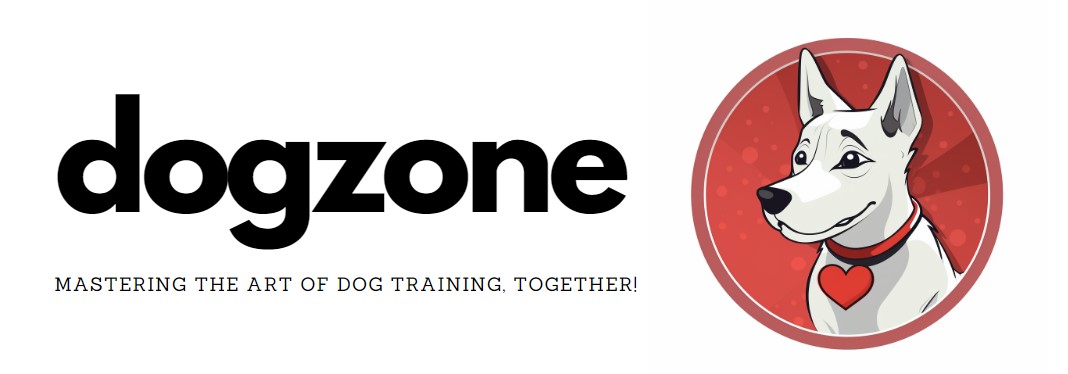
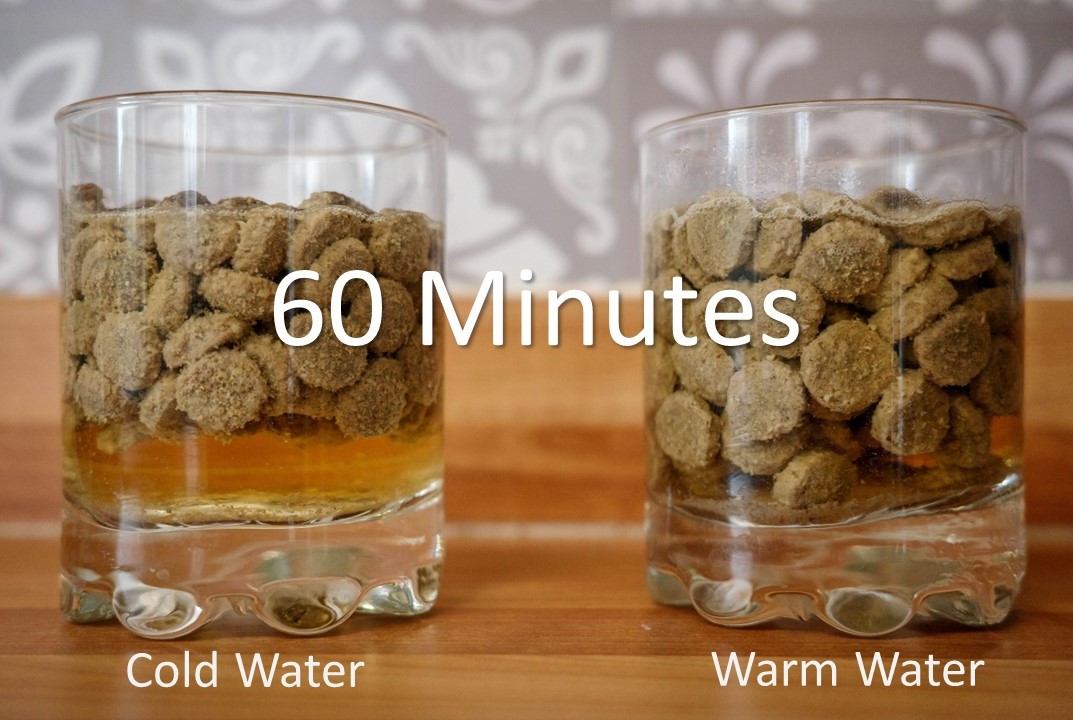
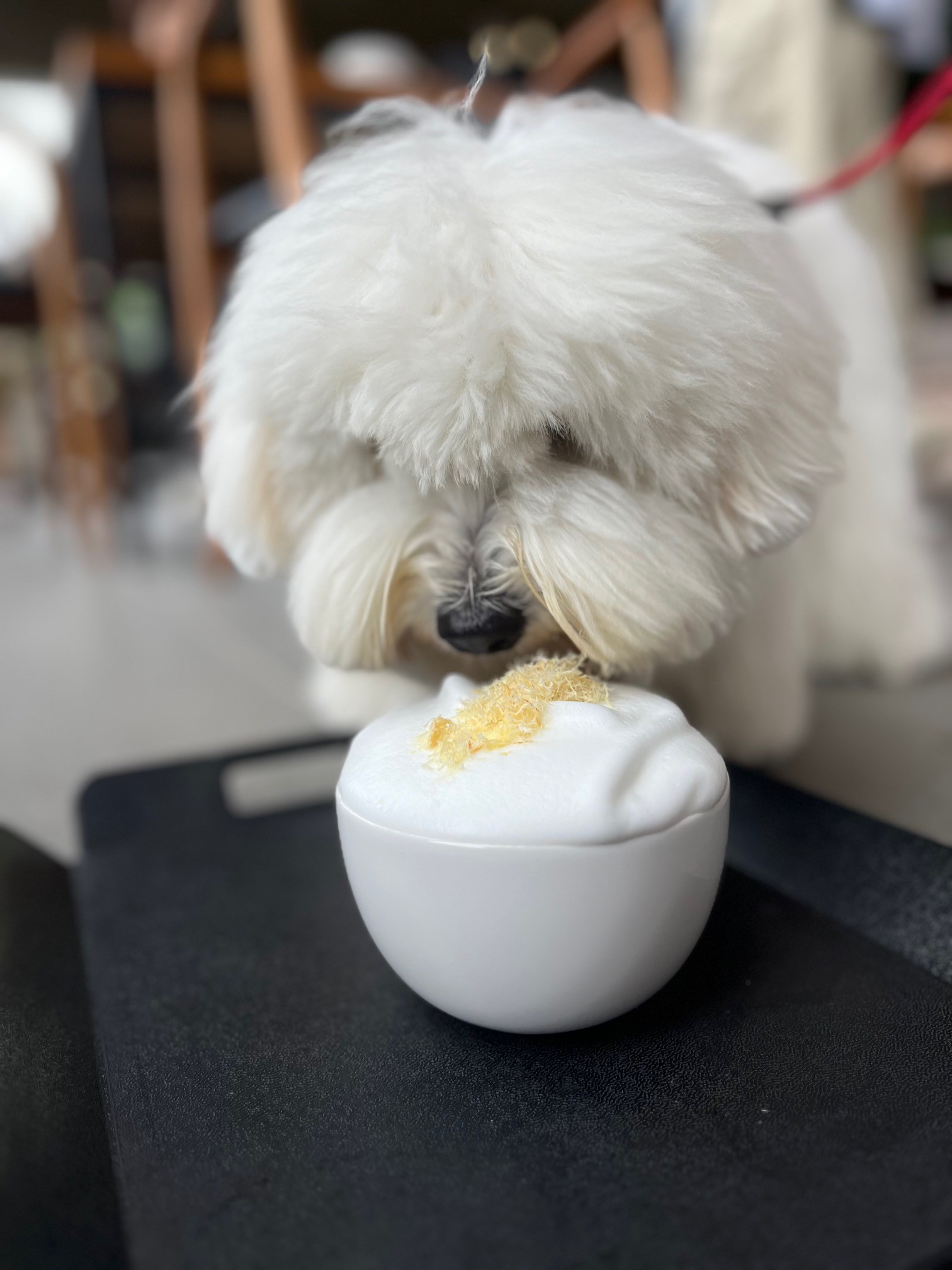
Leave a Reply